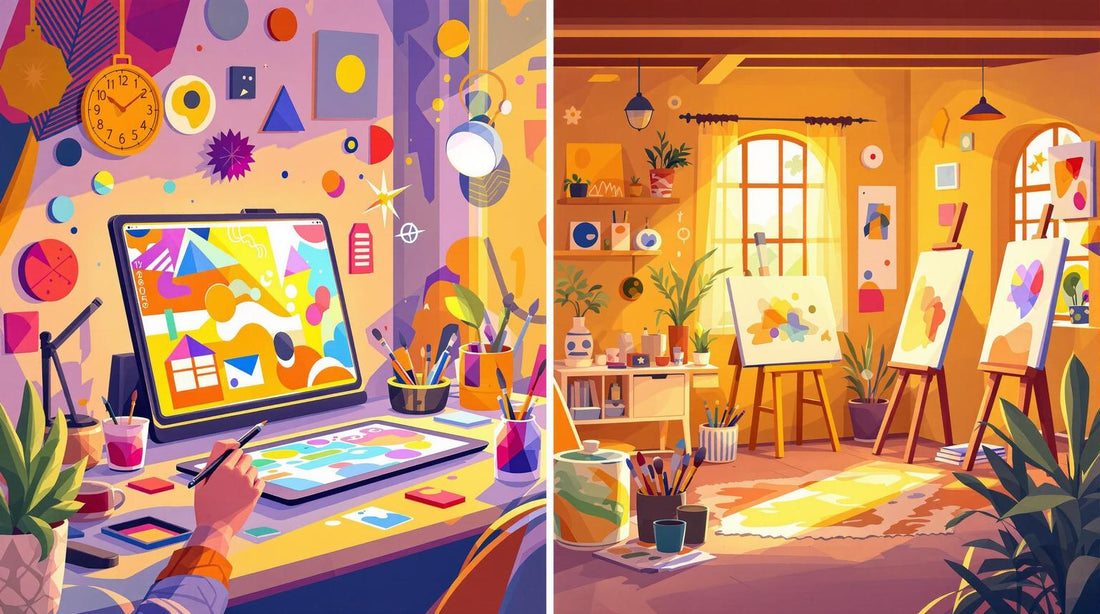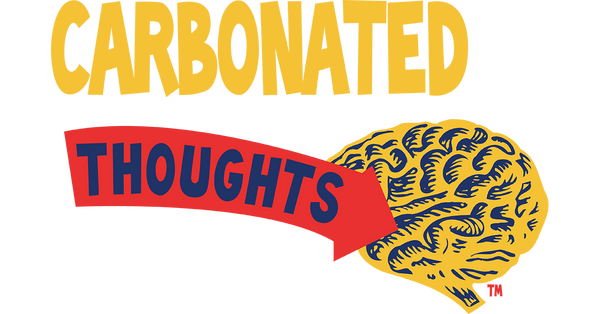
Digital vs Traditional Art: Which Style Suits Your Brand?
Share
Choosing between digital and hand-made art can shape your brand's identity and how it connects with your audience.
- Digital art is precise, scalable, and cost-efficient. It’s ideal for fast-paced brands needing consistent visuals across platforms.
- Hand-made art offers a personal, tactile feel, resonating with audiences valuing craftsmanship and heritage.
Quick Comparison
| Aspect | Digital Art | Hand-Made Art |
|---|---|---|
| Visual Style | Clean, consistent | Organic, textured |
| Revisions | Quick and unlimited | Limited and permanent |
| Production Speed | Faster | Slower |
| Cost | One-time software investment | Ongoing material expenses |
| Reproducibility | Perfect copies at scale | Unique, one-of-a-kind pieces |
| Storage | Digital backups | Physical preservation needed |
Key Questions to Consider:
- Does your brand prioritize innovation or heritage?
- Are you targeting tech-savvy or tradition-loving audiences?
- What’s your budget and timeline for creating art?
Both styles have strengths. Digital art works well for modern, scalable branding, while hand-made art delivers a personal, crafted touch. Choose based on your brand’s goals, audience, and resources.
Digital Art Basics
Digital Art Fundamentals
Digital art has transformed branding by offering diverse creation methods. Designers often turn to tools like Figma, Procreate, and Canva to meet branding needs. At its core, digital art in branding relies on two main principles:
- Technical precision: Digital tools ensure pixel-perfect accuracy and consistent brand elements.
- Creative flexibility: Artists can experiment freely, exploring ideas without worrying about material waste, which encourages bold and fresh designs.
These principles lay the groundwork for effective branding strategies.
Common Digital Branding Methods
Digital branding uses specific techniques to create cohesive visual identities. By combining various forms of digital art, brands can establish a unified and recognizable presence:
| Method | Application | Resolution Requirements |
|---|---|---|
| Social Media Art | Brand storytelling, engagement | 72 DPI for sharing |
| Print Materials | Business cards, brochures | 300 DPI for sharp output |
| Web Graphics | Websites, digital ads | Screen-optimized formats |
Digital Art Benefits
Digital art offers several advantages for building and sustaining a brand:
-
Cost Efficiency
Using digital art reduces material expenses and waste compared to traditional methods. While the upfront cost of software can be high, the savings over time are considerable. -
Scalability
Digital artwork can be adjusted across different platforms and sizes without losing quality, ensuring a consistent appearance. -
Collaboration and Storage
Digital files make it easy to share work instantly, enabling seamless collaboration across global teams. Cloud storage solutions also ensure secure and accessible file preservation.
Hand-Made Art Basics
Hand-Made Art Fundamentals
Creating art by hand relies on physical tools like pencils, charcoal, oil paints, and canvas. These tools bring out textures and imperfections that digital techniques often struggle to emulate. This process reflects a sense of craftsmanship and personal touch. Hand-made art stands out for its ability to produce designs that connect deeply with people, making it an ideal choice for brands that prioritize heritage and individuality.
Hand-Made Branding Methods
Traditional branding uses physical art techniques to craft memorable visual identities. Some popular methods include:
| Method | Application | Ideal For |
|---|---|---|
| Hand Lettering | Logos, Headlines | Heritage Brands |
| Watercolor | Backgrounds, Textures | Artisanal Products |
| Calligraphy | Signatures, Certificates | Luxury Brands |
| Sketching | Product Illustrations | Custom Services |
These methods are perfect for brands that highlight craftsmanship and tradition. Take Pendleton Woolen Mills, for instance. Their designs incorporate hand-made elements that reflect their deep-rooted values. As President C. M. (Mort) Bishop III puts it:
"Our heritage is a lot more than a simple matter of using historical materials in marketing and branding for the sake of profit. It's our DNA. It's who we are, where we've been, and where we're going. Our history, heritage, and authenticity are continually evolving in contemporary ways as we reach out to customers around the country and around the world."
Hand-Made Art Benefits
-
Authenticity and Heritage
Hand-made art communicates a sense of authenticity and history, helping heritage brands foster emotional connections with their audience. This can also justify higher pricing for their products. -
Cultural Preservation
By using traditional techniques, brands help keep cultural craftsmanship alive. For example, in Fall/Winter 2016, Gucci collaborated with graffiti artist Gucci Ghost to merge bootleg-inspired and traditional designs, blending heritage with modern streetwear aesthetics. - Unique Brand Expression
"If you're on a budget, I'd say that a logo and a color palette are probably your best bet just to get started."
This philosophy allows brands to create distinct visual identities using personal artistic touches. From hand-drawn service icons to custom thank-you cards, scanning traditional artwork bridges the tactile charm of hand-made creations with the versatility of digital platforms.
Digital vs Hand-Made Art Comparison
Main Differences
Choosing between digital and hand-made art can influence your brand's identity and how you approach production. Digital art is known for its speed and precision, while hand-made art brings a tactile, personal touch that appeals to certain audiences.
| Aspect | Digital Art | Hand-Made Art |
|---|---|---|
| Visual Style | Clean, precise, consistent | Organic, textured, unique flaws |
| Revision Process | Quick edits, unlimited undos | Limited changes, permanent marks |
| Production Speed | Faster workflows, automated tools | Slower, manual process |
| Initial Cost | Investment in hardware/software | Ongoing material expenses |
| Reproducibility | Perfect copies at scale | Each piece is one of a kind |
| Storage | Digital storage, backups needed | Physical storage, preservation required |
These factors can help determine which approach aligns better with your brand's goals.
Best Fits for Different Brands
Understanding these differences makes it easier to decide which style suits your brand. Hand-made art (often called traditional art) and digital art cater to different audiences and values.
"On an iPad you draw a bit differently, but that's all you do. Drawing is 50,000 years old, isn't it? I think it comes from very deep within us actually."
Here’s how different brands might align with these styles:
- Luxury brands: Emphasize craftsmanship and personal touch
- Heritage companies: Highlight historical connections
- Artisanal products: Showcase handmade quality
- Tech startups: Reflect digital innovation
- Modern retail: Prioritize scalable, consistent visuals
- Global brands: Ensure standardized presentation
Time and Budget Facts
Practical factors like time and budget also play a role. Digital art speeds up production and minimizes costs with powerful tools, while hand-made art requires more time and ongoing material expenses.
"Digital art is not easier than traditional art, but it is absolutely more convenient compared to most types of traditional art - more convenient to experiment, to fix mistakes, to change direction mid-painting, etc."
Digital Art Considerations:
- One-time costs for software and hardware
- Low ongoing expenses
- Quick revisions and scaling
Hand-Made Art Considerations:
- Regular material costs
- Space for storage and preservation
- Longer production times
- Special requirements for reproductions
Ultimately, your choice depends on your brand's values, target audience, and resources. Digital art is ideal for efficiency and scalability, while hand-made art stands out in areas where a personal, crafted feel is key.
sbb-itb-e116ef9
Related video from YouTube
Picking Your Art Style
Choosing the right art style means finding the approach that matches your brand's identity and day-to-day operations.
Decision Checklist
To decide between digital and traditional art, think about these key areas. Use the table below to evaluate your brand's needs:
| Assessment Area | Questions to Consider |
|---|---|
| Brand Values | Does your brand focus on craftsmanship or lean toward innovation? |
| Target Demographics | What age group is your audience? How comfortable are they with technology? |
| Production Needs | How often do you need new artwork? How flexible do revisions need to be? |
| Budget Structure | Can you afford upfront costs for digital tools, or would ongoing material expenses work better? |
| Team Capabilities | Does your team specialize in digital tools or traditional techniques? |
| Timeline Requirements | How fast do you need to create and adjust artwork? |
These points will help you choose a style that fits your brand and ensures smooth execution.
Implementation Steps
-
Assessment Phase
Evaluate your brand's goals, budget, timeline, and team expertise. Look at both short-term and long-term needs to make a balanced decision. -
Resource Planning
- For digital art: Invest in the right software and hardware.
- For traditional art: Build relationships with reliable material suppliers and set up a workspace for tools and storage.
-
Skill Development
Digital art requires learning specific software, while traditional art demands consistent practice. Set aside time for targeted training to improve your team’s skills. -
Integration Strategy
Develop a plan to update your brand guide, organize assets, maintain quality, and back up files. Experiment with both styles early on to fine-tune your process.
The art style you choose should reflect your brand's identity while meeting practical needs. Aim for a workflow that supports your current goals and can adapt as your brand grows or market trends shift.
Conclusion
Main Points
Deciding between digital and traditional art depends on aligning your brand's identity with its specific needs. Digital art offers versatility and cost savings, making it a go-to for modern brands. On the other hand, traditional art brings a handcrafted, personal feel that appeals to audiences who appreciate heritage and craftsmanship.
David Hockney highlights this distinction, saying:
"On an iPad you draw a bit differently, but that's all you do. Drawing is 50,000 years old, isn't it? I think it comes from very deep within us actually".
This quote emphasizes how each medium can contribute to brand storytelling in its own way. Digital art allows for quick updates and revisions, ideal for brands that frequently refresh their visuals. Traditional art, however, offers one-of-a-kind pieces that resonate with collectors and those seeking originality. Both styles can shape a brand's visual story effectively, depending on the context.
Next Steps
Begin with a visual brand audit to identify aesthetic gaps and determine whether the adaptability of digital art or the handcrafted appeal of traditional art aligns better with your goals. This process will help you create a cohesive visual branding strategy.
As Nouriel Gino Yazdinian puts it:
"Digital art offers efficiency, flexibility, and easier sharing, while traditional art provides tangible originals, emotional value, and a lower short-term cost. Finding a balance between both is key".
Ultimately, the medium you choose should serve as a tool to communicate your brand's message and vision effectively.
